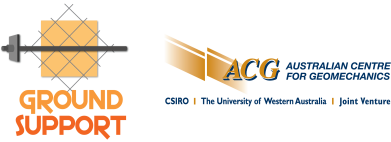Keynote Speakers
Ground Support 2023
10–12 October 2023 | Perth, Western Australia
Hyatt Regency Perth

Dr Will Bawden
President
Mine Design Technologies, Canada
Dr Bawden received his BSc and MS in engineering geology in 1970 and 1972 respectively and his PhD in rock mechanics in 1980. Following brief periods working in the civil and petroleum fields, his career has been focused on hard rock mining geomechanics with a special interest in underground geomechanical mine design. After working for the Noranda mining corporation, Dr Bawden joined academia and is a professor emeritus in the Lassonde Mineral Engineering program, Department of Civil Engineering at the University of Toronto. Along with maintaining a personal consulting practice, he is co-founding partner for two companies – Mine Design Technologies (instrumentation) and Mine Design Engineering (rock engineering services – now RocEng Inc) based in Kingston, Ontario, Canada. Dr Bawden received the rock mechanics award from the strata control committee of the Canadian Institute of Mining, Metallurgy and Petroleum. He is a registered professional engineer in Ontario and British Columbia, a fellow and life member of the Canadian Institute of Mining, Metallurgy and Petroleum, a fellow of the Canadian Academy of Engineering, and an American Rock Mechanics Association fellow.
Keynote title: The ground support life cycle considering real time ground consumption monitoring
Ground support, in its various forms, serves primarily to maintain ground integrity and hence, personnel safety and operational integrity over the operating life of the excavation/s. Ground support damage occurring during mine production and the requisite support rehabilitation represent major risk and cost factors impacting underground mines. These factors become more severe as mining depths and extraction ratios increase. This paper suggests a methodology to better manage both the increased risk and cost issues through near real‑time monitoring of ground support consumption through the full extraction cycle.

Greig Knox
PhD Student
University of Toronto, Canada
Greig completed his B.Sc. in electro-mechanical engineering followed by an M.Sc. in mechanical engineering at the University of Cape Town. Upon graduation, he joined an engineering consultancy developing sensory systems for testing, security, and aeronautical applications. One such system was New Concept Mining’s dynamic impact tester for impact tests of rockbolts which led to his employment at New Concept Mining as a test engineer in 2017. It was in this role that the challenges and opportunities associated with ground support and product development quickly captivated his interest. This developed a passion for understanding rock reinforcement in extreme ground conditions.
Greig has written and published several papers highlighting the importance of understanding impact test configurations and parameters, and their effect on the recorded performance of the rock reinforcement element being tested.
In 2020, Greig enrolled in a doctoral program at the University of Toronto. The key focus area of his research is a laboratory-based investigation into the performance of new energy absorbing rock reinforcement technologies developed for extreme ground conditions.
Keynote title: Laboratory impact testing of rock reinforcement

Johnson Ooi
Geotechnical Superintendent
Rio Tinto
Johnson is a chartered geotechnical engineer with 14 years’ experience. After obtaining a civil engineering degree, he began his career at Argyle Diamond where he was responsible for geotechnical aspects of development, production, draw control, rehabilitation, subsidence management and closure of underground and surface mines. He then joined Oyu Tolgoi in 2018 and was responsible for the geotechnical and caving aspect of Hugo North Lift 1 with regard to detailed design and mid- to long-range planning. He has developed rehabilitation strategies for re-opening collapsed drawpoints and tunnels, established workflows for incorporating geotechnical caving risk management into mine design and planning processes, and championed field trials for instrumentations such as Groundprobe’s GML scanner and Elexon’s cave flow markers.
Keynote title: Maximising ore extraction via preserving tunnel’s serviceability
Ground support design for cave mining can be daunting as the designed support must be able to endure the loading and unloading cycle from caving activities while maintaining tunnel serviceability. It is often challenging when designing ground support for copper porphyry orebodies as the rock has undergone several episodes of tectonic and geo-hydrothermal events, resulting in the rock being highly veined and having microdefects, and exhibiting duality of rock mass behaviour. At Oyu Tolgoi (OT) Hugo North Lift 1, the production footprint is located in complex rock conditions which are heavily faulted with shear zones, have a wide range of alterations, are heavily micro-defected and compounded with high-stress conditions, and have multiple stress change episodes during caving. The philosophy for OT is to preserve tunnel serviceability across different stress-change episodes, which then maximises the opportunity for ore extraction due to fewer occurrences of rehabilitation, and prevents early drawpoint closure. The engineering approach for OT’s ground support utilises a typical circular workflow; i.e. design, planning, implementation, monitoring and assurance. Emphasis during the design phase is on understanding major dominant tunnel failure modes for each time step of mining where the design process is iterative, utilising analytical, empirical and numerical approaches, to derive a fit-for-purpose support design. The planning phase incorporates advance rate and plausible frequency of rehabilitation, where risk-ranging is applied to ensure mine development and production plans are resilient and robust. The implementation phase aims to optimise the ground support installation cycle based on mapped ground conditions to improve tunnel advance rate with the highest quality. The monitoring phase is crucial to ensure that performance is compliant against the cost and schedule, where as-built data, advance rate performance and rock mass behaviours are documented and supported by a real-time data-management system for effective decision-making, and to calibrate design and planning assumptions. The assurance phase is vital to ensure ground control strategy is sound, workflows are auditable and stakeholder expectations are aligned, in order to ensure the safe work environments are sustainable and thus reserve recovery is maximised.
